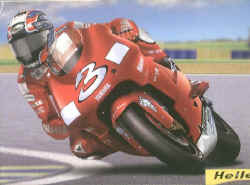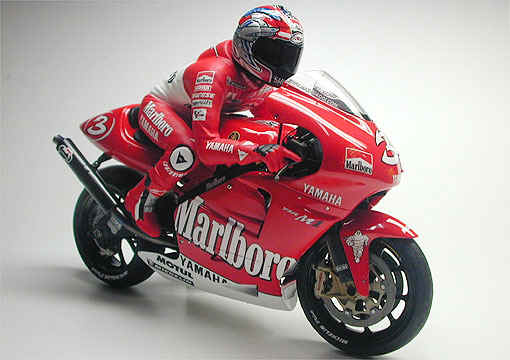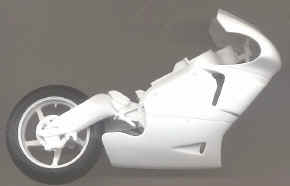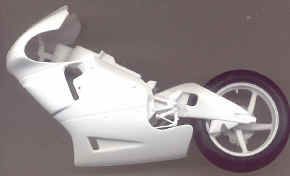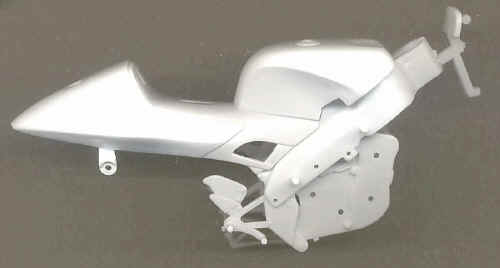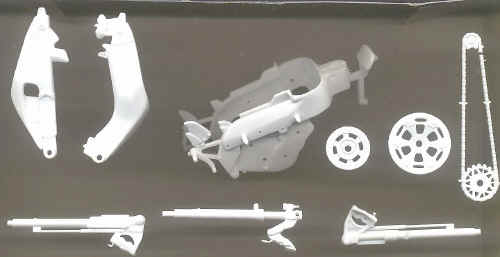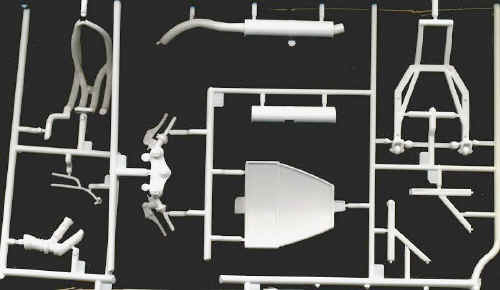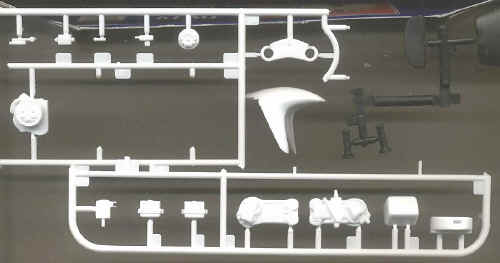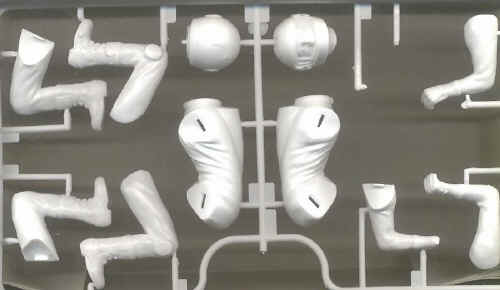 |
|||
|
Motorcycles |
|||
|
Yamaha YZR-M1 |
|||
|
by Jaime Brocal |
|||
|
Legal Notice No material from Modeler Site any Web site owned, operated, licensed, or controlled by Mario Covalski & Associated may be copied, reproduced, republished, uploaded, posted, transmitted, or distributed in any way, except that you may download one copy of the materials on any single computer for your personal, non-commercial home use only, provided you keep intact all copyright and other proprietary notices. Modification of the materials or use of the materials for any other purpose is a violation of Mario Covalski & Associated's copyright and other proprietary rights. Read More here > Legal notice I have to say I was anxious to see this kit in my hands. And I was from long ago, since I saw in Airfix/heller website that they were about to issue... 1/12th scale MotoGP bikes! Not only they had released WRC cars at a very reasonable price and with an acceptable level of quality, and at the same scale as the competition, but we had something more to cheer about: our Tamiya 1/12th bikes would never again be alone in the shelf...
Well, they announced the Honda RCV, which at that time was already scheduled by Tamiya -or it was pretty obvious that they would do so, I don't remember-. It was a pitty that they did not choose a Suzuki, Ducati, or other Aprilias. But it was the four stroke Yamaha M1 that really thrilled me, for two main reasons:
So, when I saw the two of them at the shop, I decided I would buy the Yamaha anyway, and would take a look at the Honda, just to see if Heller had got it right enough to consider the difference in price -half as much as the Tamiya issue- as a decisive factor to buy the Heller unit instead. Well, it is not. After a good surprise -wow! it has a rider inside!- I saw a series of trouble, that I will comment on the M1 later on, and which had a worse effect on the accuracy in the reproduction of the RCV. Analyzing the Yamaha Well, the model is acceptable. Maybe we should describe the general concept. If you have seen the 1/24th rally cars, you'll know what I mean: good general aspect, but sparsely detailed. Another way to see it is that, in the same way that 1/24 cars differ from their 1/43 equivalents in little less than the size, there is the same about the 1/12 bikes respect to the 1/24 ones. Same layout and parts split -anyway the same as Tamiya's, but simplified- and a level of detail that does not get the best of the size increase.
Just a fact: if the small bike has 33 parts and the big one goes up to 63, it is in part due to the number of parts of the riders, 13 vs 3. So ther is only an increase of 20 parts for the bike itself, which is 5,75 times bigger than her sister... THE MODEL Well, the model engineering is well known: laterally two-part split scheme for the engine-deltabox chasis assembly and no engine block engraving. Good reproduction of the chassis -the real thing is smooth and almost without visible welding lines- and has all the pedals and gear shift/rear brake levers included on it.
The detail is enough, but it lacks the typical crisp finish that we know in other brand... The bolts are round with few exceptions. The zone near the fork pipe anchoring has two recessed places which should be filled with putty. The swing arm is also right-left split and has two recessed zones to fill, too. Detailing is soft, even though everything is in place. The swing arm is not covered in the inside -neither are Tamiya's- but that is not hard to fix, with some plastic sheet.
The rest are made up of a set of parts that cover the block to make the impression that it really does exist. The main flaw in this approach is that the gap between the engine and the chassis spars is covered with material, with all the small complement that outstand from the block. It is a little bit like the engine bays in the old die-cast models. You can always cut off the engine block from the rest and try to build something, adding the separate parts... or wait to some aftermarket to release some resin engine. Third way would be not looking too hard under the body panels! Radiator is fine, but water ducts are to forget. Exhausts are really bad. They even "forgot" the exhaust pipe hole, which is... 1/8" in diameter!!
The last mechanical part is the fork: simple, but everything is in place. With a good paint job and some added detail -difficult, since everything is stuck together- It will suit. But you only have to compare with the YZR fork, from a "Japanese kit maker". (center fork figure 1) Before going to the cowling, just a note about the brake disks. The front one is not really something to write home, only the rear one is acceptable. Both are only detailed in the outside thus visible side. The same for the chain-pinions assembly. Acceptable, but just detailed at one side. Wheels are just fine: rims have the correct shape, with no simplification and tyres, although a bit rough, are OK, but don't look for any marking at the sidewalls.
Cowling The main cowling is made in one piece, with this typical Heller plastic: soft and easy to work with. It has some mold lines, but they are easy to sand off, due to the important fact that surfaces are even on both sides of the line -which is more important then the line itself. The shapes are faithfully reproduced, although the edges are a bit rough, particularly at the zone that covers the hands, where some material in the inside is lacking, by the way -see image. The zone that surrounds the clear doom lacks some smoothness, so some putty should be added. Air outlets lack a little deepness and their leading edges are too thick -they should be sharp- but this last problem is easy to solve by the modeler -see image. The rhomboid mark on the nose of cowling, which is supposed to represent the hole for the in-board camera, is a joke, as is the dashboard. The kit comes with some vinyl tube for brake and clutch lines. No reproduction of the carburetors or the "real" fuel tank -the outer and visible one is just a cowling in the real bike- is made. About the rest of the body, fenders are good -not too complicated shape- and the tank-seat assembly is well done, with slight mould lines located at easy to sand places. It fits perfectly to the chassis
The rider The body is correct, with realistic wrinkles in the overalls. They are correct in shape, texture and size. I cannot say the same about legs and, specially arms. Hands are very bad, with fingers straight pointing down and a... thumb? Some work to do or wait for the artisans to offer some spare. Boots are OK, they even have the protection tabs and complements taht make them look as the ones worn by Biaggi!!!. Unfortunately, the design is better than the fines of detail achieved. I did not have the time to check if the Rossi figure -in the RCV- was different, but I suspect it is the same as the one in the M1. Because this one does reproduce Biaggi equipment, as we can see in the lines on the overalls that define the colour scheme. The helmet is good and it really intends to reproduce Biaggi's SUOMY model. It is achieved but for the tabs covering the visor pivoting points. But they can easily be corrected. The visor itself is well done, surprisingly clear enough -it is injected poliestyrene- and I don't think you'll need to replace it with an acetate or negative film piece.You can always add the typical "tear away" visors that riders use to get rid of the dirt that accumulates on their screens.
Decals: They are correct. The white covers enough, colors are well printed in their place and have a correct shine, different for tyre decals and the rest. Of course, "non smoking" version.
Conclusion First of all, and despite the criticisms, a big THANK YOU to Heller/Airfix for entering this arena and offering an alternative product, with rider, original model and at a price half the usual one. Nowadays, and thinking about how much may cost a license in MotoGP, it is something MUCH to be grateful about. That's a little bit my philosophy: I prefer having a not much detailed model rather than no model. I have never been keen to establish a numeral between 1 and 10 for a quality/price ratio. Models are paid by the wallet but wished then chosen with the hart, so I prefer to name some factors that could lead you to buy it or not. So, buy it if: -you just want to have the M1, build it without thinking too much about it and contemplate it beside the rest of MotoGP bikes. -you are ready to make a lot of scratch to show the mechanics. -you simply like the bike -it is gorgeous!- because nobody else will probably make it, at least in plastic kit format. But don't buy it if: -you know some "Japanese brand" will issue it. -you fancy the detail accuracy beyond everything else, you look hard under the cowlings or use to think that Tamiya bikes are OK but need upgrade sets. Anyway... well: 2001 or 2000 Feraris, WRC Mitsubishis, Yamahas... you know models painted with Bright Red TS49 look so fine...!! More info Rubber tyres, vynil tubing, clear screens, rest of parts moulded in white soft plastic. Rider in straight running position included. Decals for one version and rider (Biaggi). Price: around 20 EUR Support us ordering our notes in PDF > Here |
|||
